Unveiling the Leather Star: A Deep Dive into the Pacific Coast’s Unique Sea Star
The Leather Star, scientifically known as Dermasterias imbricata, is a captivating sea star endemic to the Pacific Coast of North America. Distinct from its more familiar five‑armed cousins, the Leather Star boasts remarkable flexibility and a unique ecological role. This article explores every facet of this intriguing creature, from its physical characteristics and life cycle to its habitat, diet, and the challenges it currently faces.

Physical Characteristics: Beyond the Five Arms
What immediately sets the Leather Star apart is its arm count. Unlike most sea stars with five or more arms, Leather Stars typically possess ten to fifteen arms, though some individuals can have up to twenty. These arms are not rigid like those of other species; they are incredibly flexible, giving the Leather Star a somewhat flattened, almost ribbon‑like appearance. This flexibility allows it to navigate complex environments and contort its body to access prey.
The Leather Star’s color ranges from shades of brown, orange, and purple. This coloration provides camouflage against the rocky substrates it inhabits. Individuals can also exhibit mottled patterns. Average size is between 6 to 10 inches in diameter, though they can grow larger under optimal conditions.
Habitat and Distribution: A Coastal Specialist
Leather Stars are found exclusively along the Pacific Coast of North America, stretching from Alaska to Baja California. They favor rocky intertidal and subtidal zones, clinging to rocks, kelp forests, and eelgrass beds. Their distribution is heavily influenced by water temperature and salinity. They are most abundant in cooler waters and are rarely found in warmer, more saline environments. These sea stars prefer areas with strong currents, which provide a constant supply of food and oxygen.
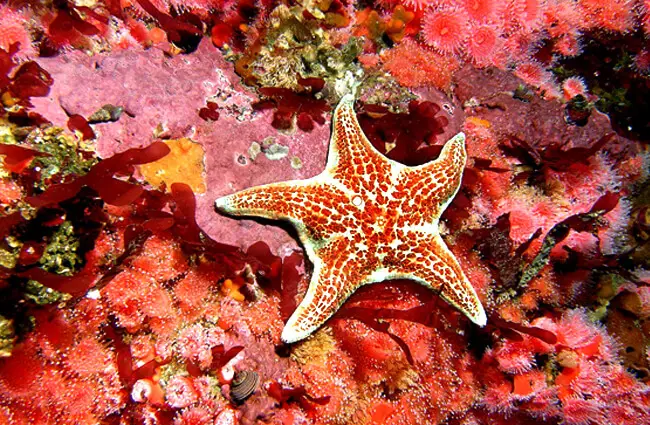
Diet and Feeding Habits: An Opportunistic Predator
The Leather Star is a carnivorous predator, feeding on a variety of benthic invertebrates. Its diet includes mussels, clams, snails, barnacles, sea urchins, and other small crustaceans. A particularly fascinating aspect of its feeding behavior is its ability to digest prey outside of its body. The Leather Star can extend its stomach outside its mouth to engulf and digest prey, a process called external digestion. This is particularly useful when consuming larger or hard‑shelled organisms. They use tube feet, small suction‑cup‑like structures on the underside of their arms, to pry open shells and capture prey.
Reproduction and Life Cycle: A Complex Process
Leather Stars reproduce sexually, with spawning typically occurring in the spring and summer months. Females release eggs into the water column, and males release sperm, leading to external fertilization. The resulting larvae, called planktonic bipinnaria, drift in the water column for several weeks, feeding on phytoplankton. As they develop, they undergo metamorphosis, transforming into juvenile sea stars that settle on the seafloor. The lifespan of a Leather Star is estimated to be around 30 to 40 years.
![Closeup of a Leather Star Photo by: Chad King / NOAA MBNMS [Public domain]](https://animals.net/wp-content/uploads/2020/01/Leather-Star-6-650x425.jpg)
Ecological Role and Interactions
Leather Stars play a vital role in maintaining the health of their ecosystems. As predators, they help control populations of benthic invertebrates, preventing any single species from becoming dominant. This contributes to biodiversity and stability within the intertidal and subtidal communities. They also serve as a food source for other marine animals, such as sea otters and certain species of fish. Their presence is an indicator of a healthy marine environment.
They frequently interact with other sea star species, sometimes coexisting peacefully and other times competing for resources. They have also been observed to exhibit commensal relationships with certain types of barnacles, which attach to their arms for transport.
Leather Stars and Humans: From Cultural Significance to Conservation Concerns
Historically, Leather Stars held cultural significance for Indigenous peoples along the Pacific Coast. They were often depicted in art and used in traditional ceremonies. Today, however, Leather Stars face a number of threats, including habitat loss, pollution, and climate change. Ocean acidification, a consequence of increased carbon dioxide levels in the atmosphere, poses a particularly serious threat, as it can weaken their skeletal structures. A recent and devastating outbreak of Sea Star Wasting Disease has significantly impacted Leather Star populations in many areas.
![Leather Sea Star at the Olympic Coast National Marine Sanctuary Photo by: David J. Ruck, NOAA Office of National Marine Sanctuaries [public domain] https://creativecommons.org/licenses/by/2.0](https://animals.net/wp-content/uploads/2020/01/Leather-Star-3-650x425.jpg)
Encountering a Leather Star: What to Do
If you encounter a Leather Star while exploring the coast, observe it from a distance and avoid disturbing it. Do not attempt to move or handle the sea star, as this can cause stress and damage. If you observe a sea star exhibiting signs of Sea Star Wasting Disease—such as lesions, tissue decay, or unusual behavior—report your observations to local marine biologists or conservation organizations.
Caring for Leather Stars in Captivity
Caring for Leather Stars in captivity requires specialized knowledge and facilities. They need a large tank with a well‑maintained filtration system, appropriate water temperature, and a varied diet of fresh seafood. Regular water changes and monitoring of water quality are essential. Providing a complex environment with rocks, caves, and other structures can help stimulate their natural behaviors. Avoid overcrowding the tank, as this can increase the risk of disease.
Fascinating Facts about Leather Stars
- Leather Stars can regenerate lost arms, although the process can be slow and energy intensive.
- They are capable of moving surprisingly quickly for a sea star, using their flexible arms to glide across the seafloor.
- Their tube feet are not only used for locomotion and feeding but also for respiration.
- Leather Stars have eyespots at the tip of each arm, which can detect light and shadow.
- They are relatively long‑lived sea stars, with some individuals living for over 40 years.

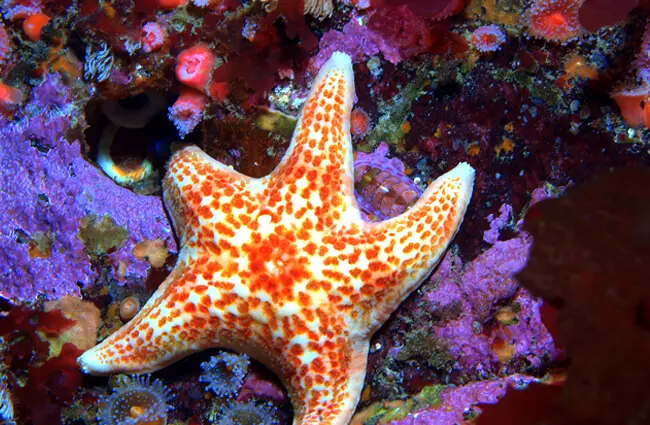
Protecting the Future of the Leather Star
The Leather Star, with its unique characteristics and ecological importance, is a treasure of the Pacific Coast. By understanding its biology, ecology, and the threats it faces, we can contribute to its conservation and ensure that future generations can marvel at this remarkable creature. Supporting marine conservation organizations, reducing our carbon footprint, and practicing responsible coastal tourism are all crucial steps in protecting the Leather Star and its habitat.

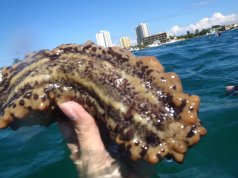
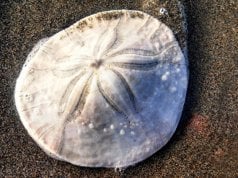
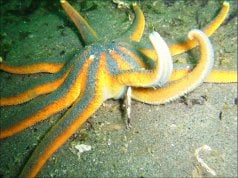

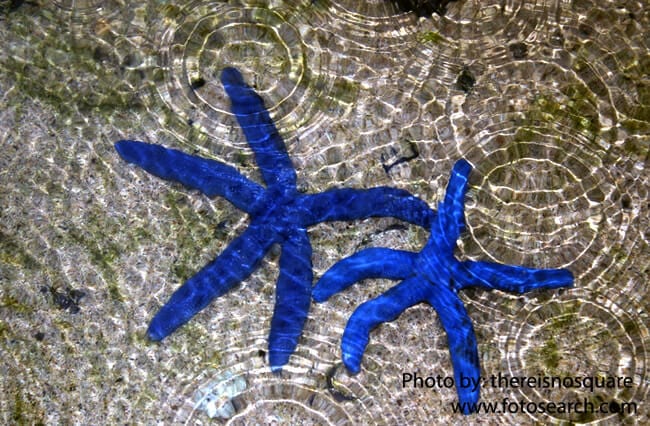
![Red Angus Closeup of a beautiful Red Angus cowPhoto by: U.S. Department of Agriculture [pubic domain]https://creativecommons.org/licenses/by/2.0/](https://animals.net/wp-content/uploads/2020/03/Red-Angus-4-100x75.jpg)

